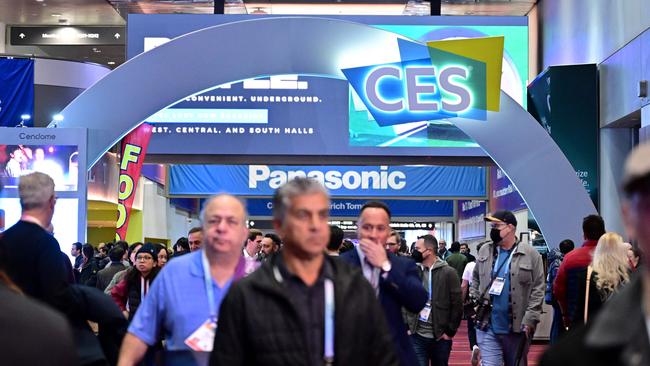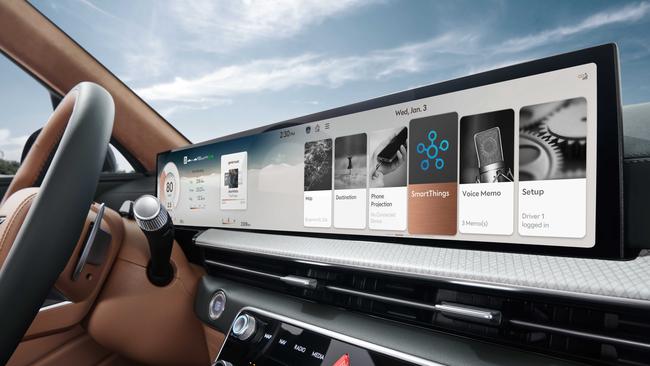CES Las Vegas 2024: Technology teaches us not everything is as it seems
Technological improvements are happening so quickly that images we see are no longer as they originally were, because they’re being manipulated in real time. Here are some highlights of CES 2024.

Real-time image manipulation is changing the world – altering what’s in front of us to be clearer, sharper or sometimes removing it altogether.
That manipulation is taking place at all levels, with newer devices able to incorporate the technology not just at the processing stage but also at the moment of capture.
The outcome can be on one hand a clearer, brighter image and on the other a still shot turned into a moving image, able to bring the dead seemingly back to life.
The technology was on full display at CES last week – the behemoth trade show which drew 130,000 people to halls, meeting rooms and conferences centres in some of America’s most lavish casinos along the Las Vegas trip.

About 4000 exhibitors were there to present their latest feats in technology, with many setting up what they believed to be the home of the future.
In the Eureka Hall where start-ups world over take big dreams to small stands, a Taiwanese business called LightMatrix showed a 3D photo frame it has developed.
“All the photos we use are actually 2D and once uploaded into our cloud we can turn them into 3D in about 10 seconds each,” said Ting Ting Feng, one of the company’s representatives.
The technology within the frame was one of many at the show that allowed the human eye to view 3D imagery without the need for 3D glasses.
Canon was also playing in the same field, displaying how a regular image could be turned into 3D with the use of its in-house AI tools.
Meanwhile, over at the Samsung booth, a new monitor designed for gamers worked in a different fashion but with a similar outcome.
It has two cameras which track head and eye movement and then, with the use of AI, adds an effect making the game appear in 3D based on the user’s head position, explained Australian vice president of consumer electronics Jeremy Senior.
Face wearables have landed on the nose
Tracking eye movement has come a long way for some, and another start-up based in South Korea has developed a pair of earphones that can change a song or pause what’s playing based on a wink or a blink.
Yoosung Kim, one of the people behind the concept and the start-up called ID.EARS said the device could be used for health by monitoring the user’s chewing speed.

“We can then analyse that munch rate and let you know if you’re eating too fast and the kind of health effects associated with that,” he said.
Tech devices to be worn on the human face are on the rise – mostly disguised as sunglasses and earphones.
One such device from Hong Kong, a pair of sunglasses which double as earphones, is called Lemuna – and founder Sean Wang said what was unique was the ability to customise by changing the glasses’ arms with a single twist.
See-through technology
Transparent technology garnered the most interest at CES this year, and LG and Samsung were the clear showstoppers on that front.
But other, much smaller brands and start-ups proved they also have a place. One such start-up named Vxion debuted what it calls a “smart film”.
That technology isn’t glass but rather a film made with polymer liquid crystals. It can cycle between displaying content and returning to a completely transparent state.
Size matters
Not everything was about being invisible. For some, it was about being as big as possible.
Laser TVs, capable of projecting screen sizes of up to 300 inches, have emerged as the huge-screen TV trend gathers pace. Hisense is one player in that game, having now introduced its TV operating system into its projector line-up.
Projectors are proving more popular across the board, and newer models are beginning to give some TVs a run for their money in terms of resolution.
Samsung introduced an 8K projector in its Premiere line-up, which can project up to 150-inches in size from just 12-inches away from the screen. That particular device has the technology to upscale films shot in 4K and 2K.
Another – called Freestyle – showed how the corner of a room could become a screen thanks to auto-stabilising and correcting technology.
At LG, old was new again with a retro-styled projector capable of supporting 4K content and with a three-hour battery. That device should arrive in Australia later this year and sell for about $2000.
Electric cars with even smarter dashes
Another clear theme from the show was the shift to automotive tech. Just about every major technology company had something to show or say about the car space.
Over at Samsung it was a partnership with Hyundai and Kia to integrate the use of its SmartThings app into their infotainment systems, giving drivers the ability to control smart devices from the car – and those at home the ability to start a car, wind a window down or up and set the temperature.

The company’s subsidiary, Harman, was working to develop sensor technology and computer vision in vehicles which could detect when a driver was drowsy and make attempts to wake them up or stop their vehicle safely.
For Sony, its showstopping device was an electric vehicle co-developed with Honda, which the company plans to sell in the US in 2026.
The car, named Afeela-EV, stole the show momentarily when Sony drove the vehicle on to a stage using a PlayStation 5 controller.

Over at LG, the company had a concept on display which use artificial intelligence to scan not only other vehicles but people, with the technology able to use AI to scan a person and determine what glasses they were wearing, how much they cost and where they could be bought, explained the company’s Australian marketing director Gemma Lemieux.
Pet care turns robotic
Pet care has also reached new heights. According to some exhibitors, robots would not just assist humans but also their pets, with some built to play an active role in caring for and entertaining a pooch.
Ogmen Robotics is one player in that space, having developed ORo, a robot that can provide “mood enhancement” by “monitoring when your dog is sad or anxious”.
“ORo’s adaptive smart learning capabilities enable it to intuitively understand and respond to your dog’s behaviours, ensuring personalised care that improves over time,” the start-up’s brochure read.
A new robot by the name of Ballie has similar functions but can also take on the dog’s role of house patrol, using AI to determine whether windows and doors were open.
Ballie could do a little more; with the use of AI and SmartThings connectivity it could turn off app-controlled devices, play music and was able to read out messages, emails and appointments, according to its manufacturer, Samsung.

The showstopping feature for that particular robot was the ability to project a screen to show Netflix on the ceiling, to display workout content on a wall or to display animals on the ground to keep the dog amused.
LG has also entered the pets space, but rather than deliver services such as mood analysis to pets, it offered those services to humans.
The South Korean tech company promised its AI Agent could read and anticipate a homeowner’s mood with the help of AI and suggest content that could improve that.
Sensory social media
Back over in start-up land and one company working out of Israel wants to bring social media into the real world by developing a device which would allow people to send a scent along with a text.
Called iRomaScents, the start-up has developed a device about the size of two meat pies sitting on top of each other which can produce scents.
When a person receives a text and a scent via their application, the device will produce the scent when they press play.
Meet and greet
For some it wasn’t all about putting on a show, but rather using the time meet international partners in the one place.
That was the case for Jason Carrington, the founder of Cygnett, who brought a team of three over and a handful of new products to show privately in hotel rooms and meeting spaces. That product line included a new credit card-shaped tracking device that works with Apple’s FindMy technology used to track its AirTags.
The Cygnett device is slim enough to fit in a wallet, could be charged with a wireless charger and had a battery life of up to three months. The company also offered new travel chargers with different adaptors and a new 240W USB-C cable which was designed to allow high-speed data transfer supporting up to 8K – built to replace HDMI cables.
Mr Carrington said one of the biggest changes to come in 2024 for those in the charging space was the arrival of the Qi2 protocol that allows MagSafe wireless chargers to reach up to 15W.
“I think the real benefit of being here is having all of our international partners in the one place. We’re seeing a lot of growth in the travel market so we’re increasingly moving into that space,” he said.
Joseph was a guest of Samsung in Las Vegas.







To join the conversation, please log in. Don't have an account? Register
Join the conversation, you are commenting as Logout